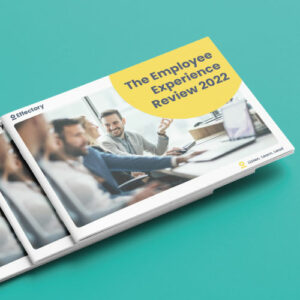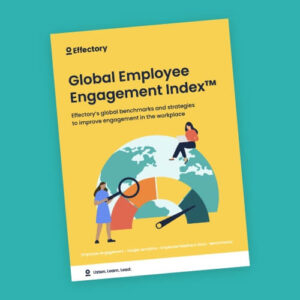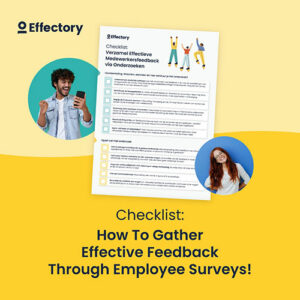In organizations around the world, employee engagement is an HR and leadership hot-topic. It’s one of the foundations to a world-beating people strategies that helps increase retention and drives productivity.
What is employee engagement? The ultimate guide to engagement

Motivate employees to become organizational ambassadors by ensuring high levels of employee engagement.
Employee engagement and the modern workplace
As Doug Conant, CEO of Campbell’s Soup, once said, “to win in the marketplace, you must first win in the workplace.” The competition for talent, both inside and outside the workplace, has never been more fierce than it is today. According to a survey by McKinsey, 40% of workers are considering leaving their current employer. Rather than simply attracting talent, organizations need to ensure that they retain high-performing employees and provide them with an environment where they can truly do their best work.
80% of executives say Employee Experience is either important or very important for them, yet only 29% of employees feel engaged or listened to. There’s a big gap between where companies want to be and where they are. It’s time to close this gap and engage employees. Many variables contribute to an employee’s desire to work with a particular organization, but employee engagement is a major factor—especially when it comes to retaining talent.
Download the Employee Experience Review
Discover how employees around the world are experiencing different parts of the employee journey and how this affects the employee experience.
DownloadChanging demographics
The dynamic between employee and organization is rapidly changing. Remote work is now much more common, and only 14% of European workers want to return to the office full time. With millennial and Gen Z workers both ranking work-life balance and flexibility as top priorities, companies are under increased pressure to meet these expectations. Consider that by 2025, these two groups will make up the majority of the global workforce.
This shift in employee needs poses new challenges for organizations, forcing them to adapt quickly. More than ever, organizations need to listen to employees to keep attracting the best talent and stay competitive.
By understanding the concept of employee engagement and its benefits, and using the employee listening tools offered by Effectory, you can develop informed strategies to engage your staff in meaningful ways. The result? A more resilient business that attracts and retains the best talent.
What is employee engagement?
At Effectory, we refined our definition of engagement. Based on our research, employee engagement can most accurately be described as “the degree to which employees are inspired and energized by their work and experience a positive connection with their work environment.”
This positive state of mind might seem self-evident at first. After all, aren’t we expected to like our work? But over three decades of research has gone into understanding the factors that affect employee engagement, and exactly why it’s so important for organizations to think about, rather than simply expect.
Global Employee Engagement Index™
Discover the Global Employee Engagement Index™ 2025 for key insights on driving employee engagement, improving performance, and enhancing team dynamics.
DownloadThe roots of employee engagement
The term “employee engagement” was coined by organizational behavior professor William Kahn in his 1990 paper Psychological Conditions of Personal Engagement and Disengagement at Work. Khan described employee engagement as follows:
The harnessing of organization members’ selves to their work roles; in engagement, people employ and express themselves physically, cognitively, and emotionally during role performances.
Kahn put forth an approach to business whereby the organization’s needs are met by investing in its most crucial asset: the people who work there. The idea is that businesses thrive when individual employees are positioned to succeed. When successfully engaged, employees will do their best work, delivering optimal results for the organization.
Modern understandings of employee engagement
With over 30 years of learnings, we can now fully appreciate the relevance of Kahn’s theory. More than just another metric to add to HR reports, employee engagement has far-reaching implications. It can be used as a tool to predict turnover based on certain markers of disengagement, as well as be a secret weapon in improving customer satisfaction. In short, it can make or break a business.
Our understanding of employee engagement is continuously evolving. Effectory has developed its intuitive and in-depth listening solutions because we’ve recognized the need for organizations to have the right tools and insights with which to improve employee engagement.
Indeed, the very act of running regular surveys that impact business decisions already helps to increase engagement, by giving employees the feeling that they can make a positive impact on an organization’s strategy and processes.
Employee engagement or satisfaction?
Because employee engagement is an important consideration, the term is often mistakenly used interchangeably with other related concepts. Terms like experience, satisfaction, motivation, commitment, and happiness relate to employee engagement, but a distinction needs to be maintained to develop effective engagement strategies.
Employee experience: This encompasses every step in an employee’s journey with the organization. It begins when a potential employee embarks on the application or recruitment process and includes every aspect of their relationship with the company right up until the moment they leave.
Job satisfaction: Satisfied employees may have positive feelings about their job, but those feelings don’t necessarily translate into focus or enthusiasm. Employees can be satisfied in their position without feeling engaged, and remain content to do the bare minimum.
Motivation: While employee engagement is the foundation for your employees to do their best work, motivation is the fuel required to do it. If, however, an employee is simply chasing a bonus, they might be motivated to temporarily improve their performance without being genuinely engaged in the long term.
Commitment: Engagement and commitment often go hand-in-hand. Effective engagement strategies should build a sense of commitment to the organization, which is why Effectory measures commitment as part of engagement. However, it’s crucial to recognize that an employee can feel engaged in their specific role without committing to the organization’s values.
Happiness: Happiness and engagement are closely linked, but not always mutually inclusive. Happiness can result from factors in the workplace, but can be equally influenced by an employee’s personal life. Nonetheless, studies show that engaged employees tend to be happier employees and vice-versa.
Disengaged employees: a world of untapped potential
Today, lack of engagement in the workplace costs the global economy an estimated $8.1 trillion annually.
The number is staggering, and mirrors Effectory’s findings, hammering home the need for employee engagement to be taken seriously. Our research reveals that only 30% of employees worldwide are engaged.
Europe has the least engaged workforce of any continent: just 23.9%. Within Europe, Ireland ranks lowest with less than 15 % of the workforce being both engaged and committed. At the high end of the scale is Austria with 34.5 %.
At the global level, 70-76% of employees are not meaningfully engaged at work or committed to their organization. Not engaging employees is a missed investment opportunity that leaves organizations less agile and resilient than they could be.
The importance and benefits of engagement
Having the right tools to track and improve employee engagement is a critical factor in organizational success. With appropriate resources and support, prioritizing employee engagement can result in a significant return on investment for your company.
When employees are engaged, they deliver superior performance, improving services for clients and customers. Employee engagement also has a positive influence on retention and absenteeism. Not only that, but employee engagement is also closely linked to higher productivity, which in turn leads to higher net profit margins. Engagement makes employees want to exceed expectations, resulting in higher performance on many levels.
Using feedback to boost engagement provides a great return on investment
This free Effectory ROI tool allows you to estimate how much your organization could profit by implementing an employee engagement strategy empowered by feedback.
Calculate your return on investmentBy the numbers: the effects of employee engagement
Here are just a few of the most significant improvements that an organization or team can achieve when employees are highly engaged. This is based on our Global Employee Engagement Index data, which surveyed over 17,000 employees in 55 countries.
- 45% increase in job satisfaction
- 42% increase in employee commitment
- 38% increase in employee retention
- 24% increase in customer focus
- 21% increase in employee efficiency
Ambassadorship: an invaluable benefit of employee engagement
Engaged employees are 34% more likely to promote and recommend their organization to others because they’re excited about their work. When employees are engaged, they become connected with—and therefore want to exemplify—their company’s values.
They become organic ambassadors for the business. A sense of belonging transforms employees into advocates of the organization and its goals outside of the workplace, attracting new clients or customers as well as potential new hires.
How Do You Measure Employee Engagement?
Improving employee engagement starts with having the right datato measure current levels of engagement.
With Effectory’s employee engagement survey, you can consistently monitor engagement throughout the organization to collect and analyze data that will direct you towards actionable strategies to improve engagement.
Direct feedback from employees is essential to this process. Improving engagement requires executive-level buy-in, but must include employees at all levels of an organization.
To deliver valuable insights, surveys should cover:
- Engagement
- Resources
- Roadblocks
- Compensation
- General wellness
- Relationships with peers and superiors
Annual or quarterly employee surveys, employee pulse surveys, focus groups, and exit interviews should all play a role in your HR strategy.
Using Effectory’s company-wide survey, Icelandair sees an 85-87% response rate. For comparison, the average traditional survey response rate is just 30%.
In order to maximize the agility of your organization, we strongly recommend Continuous Employee Listening. This system of regular feedback positions your organization to be able to quickly collect relevant information as situations arise, learn from your employees, and take action in an informed and efficient way.
Once you have a clear picture of your organization’s employee engagement levels, you’ll have crucial information which can inform strategies to increase engagement.
How to gather feedback from your employees
The definitive checklist for creating your employee engagement survey.
DownloadIncreasing Employee Engagement
At Effectory, we believe that listening to employees is crucial to employee engagement. However, you can only significantly improve employee engagement in your organization by making meaningful change based on the learnings gained through pulse or theme surveys.
Develop a strategy and stick to it
To see real improvements in engagement, you need to have an overarching strategy for addressing employee concerns and organizational shortcomings. Establishing the frequency and methods for collecting employee feedback is the first step. Next comes analysis and initiatives.
The more data you have, the better equipped you’ll be to make meaningful insights. From the very first survey you send out, however, you can begin analyzing the responses from employees and identifying patterns. Following this, you and your team will develop targeted initiatives that aim to address the specific needs expressed by your employees.
The goal is to clear roadblocks between employees and a meaningful work experience and create new opportunities for them to feel invested in the organization.
After implementing an initiative, you need to track the results and factor them into subsequent surveys. The key to optimizing the impact is continuously fine-tuning your approach based on the ongoing feedback from employees as part of your continuous listening strategy. As summarized in a 2021 Unleash Insights report:
With employee engagement cited as HR’s #1 measure of success for the last seven years, it is clearly a crucial part of any HR strategy. But it is more of a journey than a destination.
Putting your engagement strategy into action at every level
Employee engagement is a shared responsibility. It requires senior leadership, management, HR, and the employees themselves to play a role.
Leaders
An organization’s leaders establish company culture through policies, practices, and values. Senior members of a company must ensure that the organization’s values are genuinely reflected and exemplified.
Managers and supervisors
Line managers and supervisors work closely with their employees and set the tone for daily communication. The relationship employees have with their direct superiors has an essential impact on engagement.
Human Resources
HR professionals are often the first line of communication when employees encounter issues and they’re central to establishing a culture of listening. They also deal with compensation, benefits, and workplace policies, all of which play a role in engagement.
Simple Ways to Improve Employee Engagement
Here are some of the easiest techniques for improving employee engagement:
- Engaging onboarding: Start strong by making the employee’s hiring and onboarding process dynamic, individualized, and engaging.
- Company values: Establish guiding company principles so your employees can feel proud of where they work. Find small ways to demonstrate these values regularly.
- Clear mission statement: Employees have a greater sense of community and purpose when the company as a whole is working toward a clear overarching objective.
- Realistic goals: Give your team achievable short-term targets. This provides structure and frequent opportunities for employees to feel accomplished.
- Address problems: Fix the procedural issues and recurring roadblocks flagged by your employees. When organizational problems are ignored, your employees disengage and productivity plummets.
- Performance feedback: Frequent, meaningful, and balanced feedback makes employees feel seen. It also communicates to the employee that you’re invested in their development.
- Recognize individual achievements: Celebrate your employees’ successes with public recognition. Take this further by honoring those who go the extra mile with tangible rewards.
- Group volunteering: Reinforce company values by inviting employees to support a worthy cause. Do it during work hours to show that the company itself is invested in the cause too.
- Foster workplace friendships: Create opportunities for your employees to bond and encourage a sense of community. Group activities are a great way to strengthen team dynamics.
Ongoing Strategies for Employee Engagement
Here are some more far-reaching initiatives that encourage engagement in the long term:
- Meaningful work: Employees want to contribute to the company mission. Make each assignment matter—show how individual tasks are essential building blocks for larger projects.
- Employee development: Create paths for career growth within the company. Show employees that you’re investing not just in the team, but also in them as individuals.
- Flexibility: Work-life balance is more important than ever. Flexible hours and remote work options communicate to employees that you recognize their individual needs.
- Benefits: Invest in your employees’ well-being by providing mental health and fitness services. Employees are more likely to feel committed to organizations that care about their wellness.
- Positive environment: Make the office a place employees want to be. Small investments in communal spaces, workplace perks, and quality of life on the job go a long way.
- Encourage sharing ideas: When you invite employees to share their thoughts on how to better meet company goals, they’re more motivated to help the company meet those objectives.
Talk about employee engagement: The topic of employee engagement can be an open and ongoing discussion when it is part of the process of employees feeling seen and heard.
Listening to feedback with Effectory
We give organizations the tools they need to implement a continuous listening landscape. This creates a feedback loop through which management and HR can develop data-driven solutions to—sometimes unforeseen—business issues, based on insights from their human capital. Once these changes are put into place, you can regularly reassess them by surveying employees on their effectiveness.
To learn more about Effectory and how our listening solutions can improve employee engagement in your organization, schedule a product demo.
Employee Engagement Success Stories in action
Angel Trains
A UK-based rail leasing company, Angel Trains has been using Effectory’s platform for ten years to gather employee feedback and fine-tune their operation. The organization previously used a single annual survey, which provided little in terms of actionable data. After switching to Effectory, the new approach of focusing on employees began with one simple question: How often would you like to be able to provide feedback? With more frequent surveys and deeper analysis, Angel Trains has discovered previously unknown drivers of engagement, like having more opportunities for employees to meet people in other teams. This is just one of the many engagement strategies they’ve been able to initiate using Effectory’s data-driven approach.
Icelandair
Awarded the title of best European World-class Workplace in 2021, Icelandair has been working with Effectory since 2018. Following their core values of “driven by passion,” “guided by responsibility,” and “executed with simplicity,” Icelandair turned to Effectory to build a continuous listening landscape. By surveying employees more often and using scientifically-validated questions, Icelandair has been able to better meet and adapt to the evolving needs of their staff. The flexibility of the platform has enabled management to tailor their feedback strategies around individual teams and empowered them to make data-driven decisions. Effectory Listening Solutions has also helped Icelandair make the transition to hybrid working in response to an increased demand for flexibility.
Kramp
Europe’s leader in spare parts and accessories for the agricultural industry, Kramp has long recognized the impact of employee engagement on business outcomes. The company has been working with Effectory since 2013. In 2021, Kramp decided to drastically increase the frequency of their employee feedback surveys by deploying Effectory’s continuous listening program. The goal? To create a culture of feedback and action, one that would empower their employees. To get more detailed insights, surveys are embedded in daily work, while pulse surveys and question sets about specific topics are being performed at a local level. By integrating Effectory with Kramp’s Workday database, HR and management save time and have easier access to better benchmarking tools to inform their strategies.
Discover how Effectory can empower you to engage your employees
Performing surveys, hearing feedback, and using your people power to inform strategic policy decisions is a great way to increase engagement. Plus, it often gives you a competitive edge. Find out how.
Book a demo



